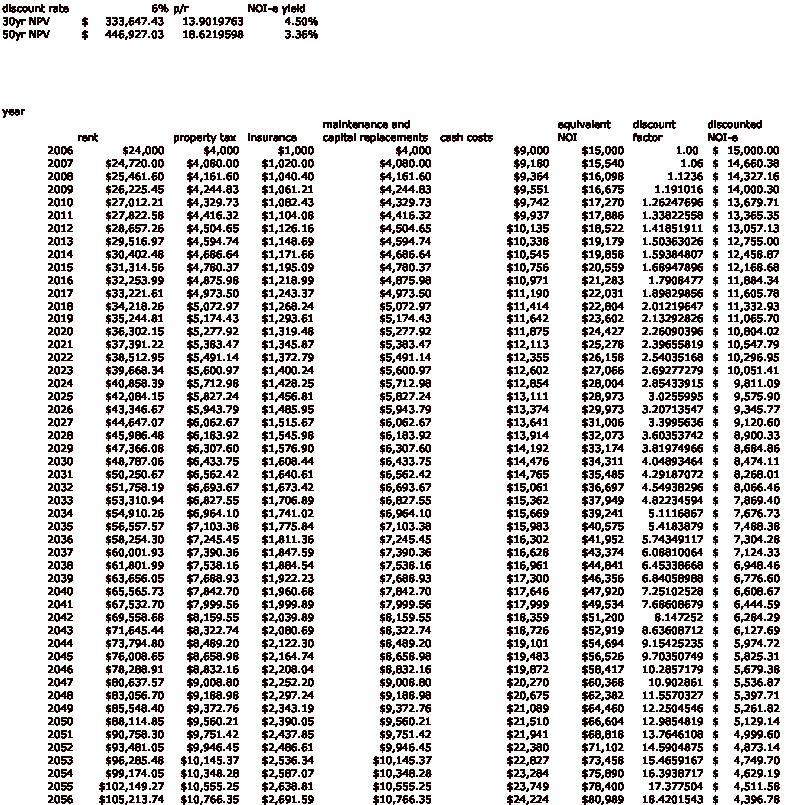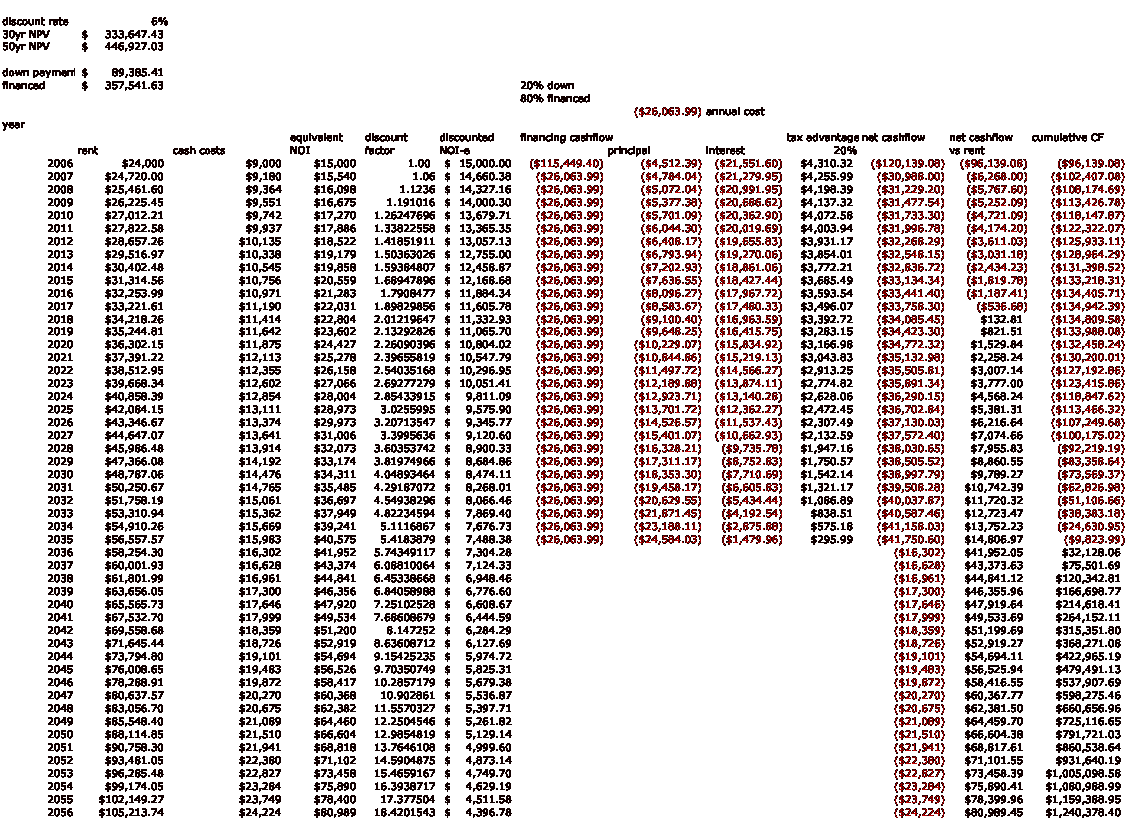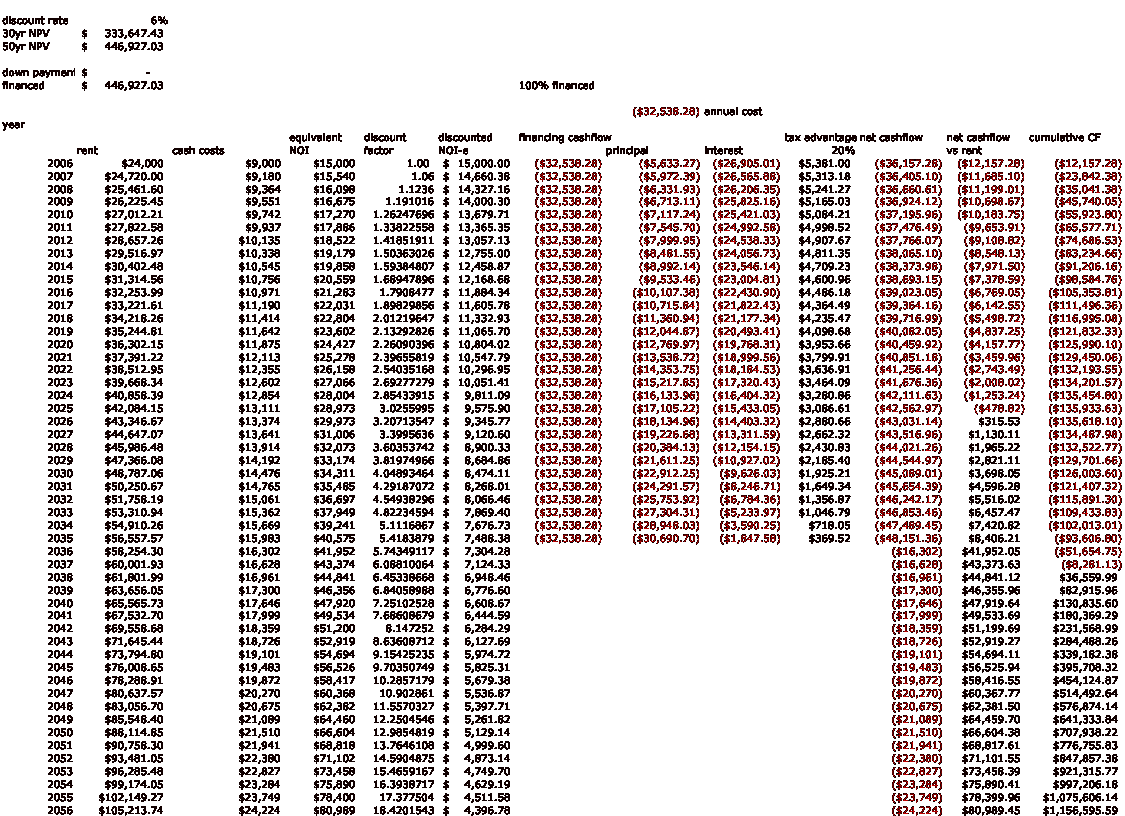Valuing Real Estate V2.0 (This Time It’s Different!)
April 9, 2006
Apparently some economist types have recently come up with a “new” way of valuing real estate, based on discounted cash flows. This justifies property values much higher than the sort of methods we used a few weeks ago, which are the methods smart investors have used for decades. Here is a link to the paper.
http://www.brookings.edu/es/commentary/journals/bpea_macro/forum/bpea200603_smith.pdf
And here is a summary from the New York Times:
http://www.nytimes.com/2006/04/01/business/01bubble.html?_r=1&oref=slogin&pagewanted=print
Whenever assets are highly priced, whatever they may be, there will inevitably appear elaborate and sensible-seeming justifications for the present pricing. Remember Dow 36,000? It appears to me that the authors of the paper just wanted a handy justification to buy their “dream house” in California, despite the fact that the market is overpriced.
To summarize, the authors argue that rental income tends to rise over time, while the coupon on bonds remains stable. Thus, even if rental yields are lower than mortgages on the same property today, that lack of cashflow today would be made up some time in the future as rents rise at their average annual pace of 3% or so. Similarly, it may “make sense” to buy today even if the monthly cash cost of owning a property is greater than equivalent rent, because the monthly cash costs would be stable while rents could rise.
Actually, that’s true — and it explains one major reason why homeownership (and investment-property-ownership) tend to be good long-term investments. The problem, of course, with pricing property on that basis is that such pricing eliminates the advantage!
Let’s look at a 30-year DCF model, based on assumptions similar to those made by the authors.

So there you go. Simple, right? This model makes several assumptions:
1) There is no allowance for occupancy or management fees. People sometimes end up with a home they aren’t living in, because of a new job or other developments. As for management fees, while theoretically it would not be necessary to find new tenants, nevertheless there is some time and effort involved in keeping the property running, whether filling out property tax forms or finding a good chimney expert.
2) The discount rate of 6% is equivalent to 30yr mortgage rates. However, there is “business risk” involved in owning, while the bank doesn’t get paid only in extreme circumstances. Thus, one could argue that the 6% discount rate is too low.
3) Property taxes, insurance and maintenance/capital replacement costs are assumed to go up only 2% per year, while equivalent rents go up 3%. This is because a) property taxes typically do not go up in line with equivalent rents, but lag somewhat, b) insurance/maintenance is related to the structure, while land itself doesn’t need any insurance/maintenance.
4) Rents are assumed to go up 3% a year, which has been typical over the last twenty years or so, and is in line with the CPI.
That said, there are some advantages of having a home over debt, primary of which is that it is a “hard asset” and thus relatively inflation-resistant. Or in other words, in an environment of inflation nominal rents could rise much faster than 3% per year. Also, it is possible that you may be in a region that is enjoying a long-term boom and above-average rent rises. But then, you may be an area that will experience below-average rent rises. Who is to say that Phoenix is not the Cleveland, Rochester or Buffalo of the future?
When you add up all these assumptions, we see that, in terms of today’s valuations, a home with a rent of $2000/month or $24,000/year would be worth about $334K on a 30-year basis and $447K on a 50-year basis. (One could stretch it out to infinity, but how long are you going to live there?) In terms of typical valuation measures, we see that the first is 14x annual rents, and the second is 18.6x. This translates into “equivalent net operating income yields” of 4.50% and 3.36%, respectively.
Thus far, we are assuming that the home is being bought for cash, no financing. On this basis, there are some additional advantages: property taxes are typically deductible, and homes have better capgains treatment than equities, though it’s hard to say why that would matter here.
Since this example is sort of a consumer-finance exercise, it would be worthwhile to look at a situation where the property was financed. In our case, we’ll use a 30yr fixed-rate mortgage, which Yahoo informs me is now going for about 6.02%. Plus, we’ll use a 20% downpayment. We’ll use the 50yr NPV of $447K as a sale price, which gives us a down payment of $89K and a mortgage of $358K. The property tax, insurance and maintenance is summarized as “cash costs” to cut the number of columns down.

Now we can see the problem with using these “DCF” valuations — you can’t finance it. Even if you put up the $89K 20% downpayment, the annual cost, even including a tax break, is about $31,000 a year, compared with $24,000 to rent. If we assume that $24,000 is all the household can afford, then where does the extra $7,000 a year come from? You have to go 12 years out, to 2018, before the cash costs are less than the rent, which is assumed to rise 3% per year. In terms of the time when the total cumulative cash payments from buying is less than renting, that is in the rightmost column. Here we see that you don’t break even until 2036, when the 30yr mortgage is paid off. So, to buy this house at the “50yr DCF” value of 18.5x annual rent, you don’t really see any advantage for 30 years versus renting.
We are assuming a big downpayment in this example. That downpayment has opportunity cost as well. For example, you could make 6.02% on it by loaning the money to someone who is buying a house. We can easily factor in this opportunity cost by assuming 100% financing (even though a bank wouldn’t let you do this, or shouldn’t anyway).

Note that we assume a 20% tax advantage on interest costs. This is less than the marginal rate, it’s true, but to get it you have to give up your standard deduction. Also, with the AMT and other tax nonsense, you aren’t likely to get the whole marginal rate deduction.
Here’s the same exercise with 100% financing:
Now we see that buying costs more than renting, on a cashflow basis, for twenty years, or until 2026. The initial annual cash cost of ownership is $36,157, compared with $24,000 to rent. And where does this extra money come from? Not an easy question to answer. Not to mention that people live in their houses for an average of seven years before moving. Of course, on an NPV basis, the costs in the present are “worth more” than the cash you get twenty years in the future. Since the discount rate and the financing costs are basically the same, you would break even at year 50 on an NPV basis — minus a little bit for the tax advantage, I expect. In other words, not real exciting.
However, it must be noted that, to the extent that rent rises represent “inflation,” a diversified REIT acts something like a Treasury Inflation Protected Security. TIPS are yielding about 2% now, plus CPI, so getting 3.5% for a REIT (common today) is arguably intriguing, especially if one believes that inflation is in the future. However, inflation also means higher interest rates and thus lower property valuations (likely), and higher interest rates mean a depressed economy, which means depressed occupancy. Unlike TIPS, there is definite economic risk involved. No easy ways to win when you buy property at elevated pricing.

